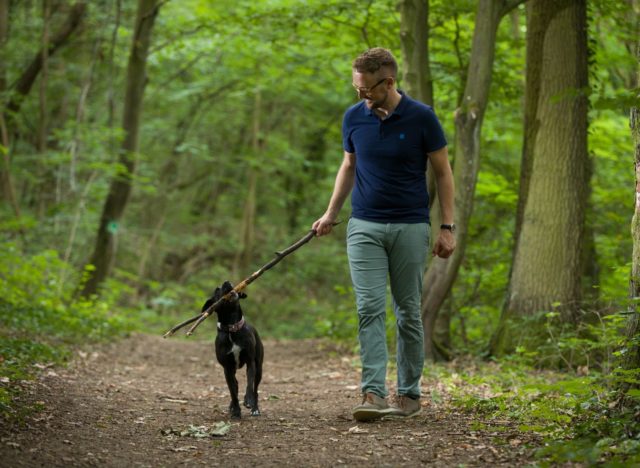
Lyme disease in dogs is caused by one of the fastest-growing tick-transmitted bacterial infections in the United States – and it can cause major health problems in dogs.
Since Lyme disease is a year-round threat, Boehringer Ingelheim would like pet owners to know how they can help protect their dogs from the bacterial infection that can lead to canine Lyme borreliosis, also known as Lyme disease.
“Dogs infected with the bacterium that can cause Lyme disease do not display a rash that would make early diagnosis possible,” said Andrew Eschner, DVM, a regional director for Veterinary Professional Services at Boehringer Ingelheim’s U.S. Animal Health Business.
Not having a tell-tale early warning sign allows the bacteria to further multiply within the dog for many weeks to months, and it is only after the dog becomes very lame, feverish, and tender to the touch (or worse) that the dog-owner becomes ‘informed’ that disease is present.”
In 2018, more than 318,000 dogs in the United States were diagnosed as infected with Borrelia burgdorferi, the bacterium that can cause Lyme disease, up from about 162,000 in 2012, according to the Companion Animal Parasite Council.
“We want pet owners to know how to keep their dogs as healthy as possible,” said Eschner, who supports a team of veterinarians in the Northeastern United States, where infection with Borrelia burgdorferi and its resulting forms of disease are endemic.
He noted that dogs love to explore areas that are home to ticks, such as trails, boundaries between lawns and woods and forest edges. Those areas often contain the thick, knee-high, leafy or grassy vegetation favored by ticks that transmit the bacteria that can cause Lyme disease. Those ticks, commonly called deer ticks or black-legged ticks, have the scientific name Ixodes scapularis.
Lyme disease continues to be concentrated in the Northeast, Upper Midwest and Mid-Atlantic states, but more cases also have been reported in recent years in places that include North Carolina, Ohio, Virginia and elsewhere.
“The problem is, with each passing year, the black-legged tick continues to fan out into new areas so everyone should be vigilant,” Eschner said.
“Dogs can become infected any time of year, but the risk is highest in spring, summer and early fall, when ticks are most active and dogs and their owners spend more time outdoors,” Eschner said. “We encourage pet owners to talk with their veterinarian about a preventive plan.”
He recommended these steps to help protect your dog:
- Make your yard less appealing to ticks by cutting grass short and eliminating brush piles.
- As much as possible, avoid areas where ticks are common, such as wooded areas.
- Check for ticks daily on you and your pet after being outside. Be sure to check closely around your pet’s ears and paws.
- Work with your veterinarian to find a product that can protect your pet against fleas and ticks. Boehringer Ingelheim’s Animal Health Business makes NexGard® (afoxolaner), the flea-and-tick-killing chew that is the only product FDA-approved to prevent the transmission of the bacteria that can cause Lyme disease by killing infected black-legged ticks.
- Talk to your veterinarian about whether a Lyme vaccine would be appropriate for your dog.
For more information, talk to your veterinarian about Lyme disease and prevention for your pet.
IMPORTANT SAFETY INFORMATION:
NexGard is for use in dogs only. The most frequently reported adverse reactions include vomiting, itching, lethargy, diarrhea and lack of appetite. The safe use of NexGard in pregnant, breeding, or lactating dogs has not been evaluated. Use with caution in dogs with a history of seizures or neurologic disorders. For more information, click here for the prescribing information or visit www.NexGardForDogs.com.
About Boehringer Ingelheim Animal Health USA Inc.
Boehringer Ingelheim is the second largest animal health business in the world, with net sales of almost $4.7 billion (3.9 billion euros) worldwide in 2018, about 10,000 employees and a presence in more than 150 markets. We have pioneered advancements in vaccines, parasite-control products and therapeutics that limit pain and slow disease, and we aim to create the future of animal wellbeing for pets, horses and livestock by focusing on prevention.
Boehringer Ingelheim’s Animal Health Business has a significant presence in the United States, with more than 3,000 employees in places that include Georgia, Missouri, Iowa, Minnesota, New Jersey and Puerto Rico.
To learn more, visit www.boehringer-ingelheim.us, www.facebook.com/BoehringerAHUS or http://www.twitter.com/Boehringer_AH.
About Boehringer Ingelheim
Improving the health of humans and animals is the goal of the research-driven pharmaceutical company Boehringer Ingelheim. The focus in doing so is on diseases for which no satisfactory treatment option exists to date. The company therefore concentrates on developing innovative therapies that can extend patients’ lives. In animal health, Boehringer Ingelheim stands for advanced prevention.
Family-owned since it was established in 1885, Boehringer Ingelheim is one of the pharmaceutical industry’s top 20 companies. Some 50,000 employees create value through innovation daily for the three business areas: human pharmaceuticals, animal health and biopharmaceuticals. In 2018, Boehringer Ingelheim achieved net sales of around $20.7 billion (17.5 billion euros). R&D expenditure of about $3.8 billion (3.2 billion euros), corresponded to 18.1 per cent of net sales.
As a family-owned company, Boehringer Ingelheim plans in generations and focuses on long-term success. The company therefore aims at organic growth from its own resources with simultaneous openness to partnerships and strategic alliances in research. In everything it does, Boehringer Ingelheim naturally adopts responsibility towards mankind and the environment.
NexGard® (afoxolaner) is a registered trademark of the Boehringer Ingelheim Group. ©2019
Boehringer Ingelheim Animal Health USA Inc., Duluth, GA. All Rights Reserved. PET-1577-NEX0519
SOURCE Boehringer Ingelheim

Related Links
http://www.boehringer-ingelheim.us

Rod Washington: Rod is a blogger, writer, filmmaker, photographer, daydreamer who likes to cook. Rod produces and directs the web series, CUPIC: Diary of an Investigator. He also produces news and documentary video projects. Check out his podcast StoriesThisMoment at https://m3e.d71.myftpupload.com/stm-tncn-podcasts/


